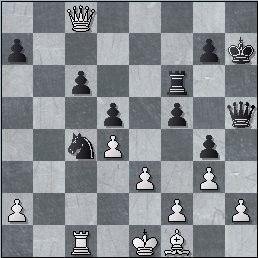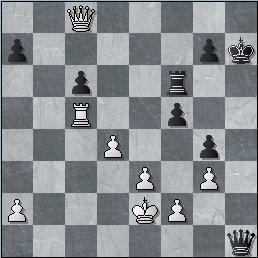12.10.2006
Game XII V.Kramnik - V.Topalov
1.d4 d5 2.c4 c6 3.Nf3 Nf6 4.e3 Bf5 5.Nc3 e6 6.Nh4 Bg6 7.Nxg6 hxg6 8.g3 Nbd7 9.Bd2 Bb4!? 10.Qb3 Previously black used to put his bishop on e7, yet Kramnik reacts rather fast. Perhaps, 9...Bb4 was analyzed by both opponents, and Topalov decided it's useful to prevent it with 9.a3, while Kramnik is going to prove its insufficiency.

10...Bxc3 11.Bxc3 Ne4 12.Bg2 Black threatened with Qd8-f6, for example, 12.Bb4? Qf6. 12.Qb7? Rb8 13.Qc6 Rb2! is also bad. 12...Nxc3 13.Qxc3 Maybe it's superficial, but it seems to me white has more chances to open the position for the bishop after 13.bxc3 13...f5!? It's difficult to evaluate black's last move. I do not think e3-e4 was a threat, the resulting position is technical, weakness on d4 gives black good chances.

14.0-0 Qe7 15.cxd5 This defines a structure, but white almost forces exd5, that will give white a target for a minority attack meanwhile and for this turn of fight black' last two moves are not much useful.
15...exd5 16.b4 Nf6 17.Rfc1 A useful move, although white could as well choose more straightforward 17.a4 or 17.Qb2 is white wants to play a2-a4 only after a7-a6...
17...Ne4 18.Qb2 0-0 Black could choose defence of a technical position with a weak c6-pawn after 18...a6 19.a4 0-0 20.b5 axb5 etc.It's defendable, but naturally Topalov prefers a more tense continuation. 19.b5 Probably, being too deep in the subtleties, Kramnik spent rather much time for this move which most of us mere mortals would make at once without hesitation, but however subtle the evaluation of various possible situations may be, no other way of developing the initiative is available. 19...Rac8 After 19...cxb5 20.Qxb5 Qf7 21.Rc2 black can hold due to his strong knight, but the position is unpleasant. 20.bxc6 bxc6

A plan a2-a4-a5-a6 was tempting but likely to cost white the c-file, thus Kramnik decided to define the structure immediately
21.Qe2 g5 22.Rb1 On 22.Rc2 white has to take 22...f4 into account, as long as 23.exf4 gxf4 24.f3 fails to 24...Qf6 22...Qd7 23.Rc2 Rf6 a passive setup was possible: pawn g4, Rooks c7, c8. It seems to me white cannot uincrease the pressure in this case, because the weakness of light squares doesn't allo him to add the bishop, while now white could think of penetration on using b-file
24.Rbc1 g4 25.Rb2 The most primitive idea for white here that comes to my mind is to put the a2 pawn to a6. Now after g4 pawn prevents Qd7-h3, we should also bear in mind Bg2xe4 which white may or may not use at the proper moment, while black has to be on alert at every move.
25...Rh6 26.Qa6! Rc7 27.Rb8 Kh7 28.Qa3 Now it's reasonable to start with 28...Rb7 and after 29.Ra8 black has to return his attacking rook: 29...Rf6 28...Rb7
29.Qf8 Rb8 30.Qb8

30...Qf7 Of course! 31.Qc8 Qh5 32.Kf1! Incredibly accurate assessment! White could secure draw by 32.Bxe4 fxe4 33.Kf1 Qf7 (33...Qxh2 34.Qf5+=) 34.Kg1, but Kramnik proves black's attack is not deadly, now after 32...Nd2+ 33.Ke1 Nc4 34.Bf1 the advantage will be on white's side.
32...Nd2+ 33.Ke1 Nc4 34.Bf1 Rf6! The position has suddenly become rather sharp. Now the variation 35.Rb1 Nd6 36.Qc6 Qh2 37.Qd5 Ne4 38.Rb2 Nxg3 39.Qg2 Nxf1 40.Kxf1 seems to lead to equality. It means that white is looking for a clean way to make draw now, because the king is under attack.

35.Bxc4 dxc4 36.Rxc4 Qxh2 37.Ke2 Qh1 38.Rc5! Black cannot add the rook to help the queen, the game has levelled.

38...Qb1 39.Qa6 39.a3 was a reasonable alternative. White doesn't need any risk after 39.Rc6 Qb5 40.Rc4 Ra6
39...Qb2 40.Kf1 Now after 40...Rh6 41.Qd3 Qa1+ [41...g6 42.Qb3] 42.Ke2 Qxa2+ 43.Qc2 an extra pawn promises nothing, black has to force draw.
40...Qb1 41.Ke2 Qb2+ 42.Kf1 Rh6 43.Qd3 g6 44.Qb3 Rh1+ 45.Kg2 Rh2+ 46.Kxh2 Qxf2+ 47.Kh1 Qf1+
Draw.
---------------------------
Summary.
In the last game of the main part of the match Topalov applied with black a new idea and was close to equalization. On exiting the opening Kramnik managed to outplay his opponent and reach small advantage, yet Topalov succeded in defending and achieved counterplay against white king. With precise moves Kramnik neutralized this emerging little danger, and the game ended up in draw by a perpetual check. Thus, unless it can be proven otherwise..., the main time of the match finished with an equal score. Shall we await penalty kicks?
